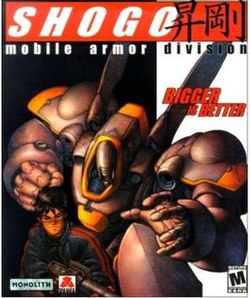Shogo: Mobile Armor Division
| Shogo: Mobile Armor Division | |
|---|---|
 |
|
| Developer(s) |
Monolith Productions Hyperion Entertainment (Amiga) |
| Publisher(s) | Titan Computer (ports) |
| Distributor(s) | Interplay Entertainment |
| Designer(s) | Craig Hubbard |
| Writer(s) | Craig Hubbard, Nathan Hendrickson |
| Composer(s) | Guy Whitmore, Daniel Bernstein |
| Engine | Lithtech |
| Platform(s) | Microsoft Windows, Mac OS, WarpOS, Linux |
| Release | September 30, 1998 (Windows) 2000 (Mac) 2001 (Amiga, Linux) |
| Genre(s) | First-person shooter |
| Mode(s) | Single-player, multiplayer |
Shogo: Mobile Armor Division is a first person shooter video game released by Monolith Productions in 1998. It was the first game to use Monolith's flagship Lithtech engine. It has heavy influences from Japanese animation, particularly Patlabor and Appleseed and the real robot mecha genre. The game allows the player to pilot a large mech, as well as perform missions on foot.
Shogo features a mix of both standard on-foot first person shooter action, and combat with anime-style bipedal mechs. Unlike mech simulator games such as the MechWarrior series, the mechs in Shogo are controlled essentially the same as in first-person shooter games.
An inherent feature of the combat system in Shogo is the possibility of critical hits, whereby attacking an enemy will occasionally bring about a health bonus for the player while the enemy in question loses more health than usual from the weapon used. However, enemy characters are also capable of scoring critical hits on the player.
Players take the role of Sanjuro Makabe, a Mobile Combat Armor (MCA) pilot and a commander in the United Corporate Authority (UCA) army, during a brutal war for the planet Cronus and its precious liquid reactant, kato. Players must locate and assassinate a rebel leader known only as Gabriel. Prior to the game's first level, Sanjuro had lost his brother, Toshiro; his best friend, Baku; and his girlfriend, Kura, during the war. He is now driven by revenge and his romantic relationship with Kathryn, Kura's sister; in Sanjuro's words, "It's kinda complicated."
At two pivotal points in the game, the player also has the opportunity to make a crucial decision, which can alter the game's ending. While the first decision is almost purely a narrative decision, the second decision actually determines who the player will be facing the rest of the game and how the game will end.
...
Wikipedia
